What would it take for you to buy a $33,000-to-$53,000 Kia instead of an Audi or BMW? Kia gave this question a lot of thought, and the new Stinger is its answer. Good answer?
Kia gets bonus point from me right off the bat for making the Stinger a liftback. (If you'd rather have a sedan, Genesis offers the closely related G70 and G80.) Historically, liftbacks have been perceived by Americans as downscale. Those with unmiserly pricing have fared poorly against sedan competitors despite their additional versatility and (when done right) sleeker shapes.
This has been changing. When Porsche finally fielded a four-door, it gave the Panamera a fifth portal. Tesla took the same unconventional route with the Model S. BMW tested the waters with its 3 and 5 Series (now 6 Series) Gran Turismos. Then, in case two wasn't enough, it also made the 4 Series Gran Coupe a liftback.
Unfortunately, if you've wanted the same combination of styling, handling, and versatility at a sub-BMW price point, you've been out of luck, as the mainstream makes offered no such car. This changed with Kia's introduction of the Stinger. With pricing from $32,800 to $52,300, the Stinger isn't cheap, just affordable relative to its German competitors.
Beyond the obvious loss of cachet, how much do you give up in exchange for a lower price? Should anyone considering one of the German liftbacks be sure to visit a Kia showroom? I tested the Stinger against the Audi S5 Sporback, also new for the 2018 model year, to find out.
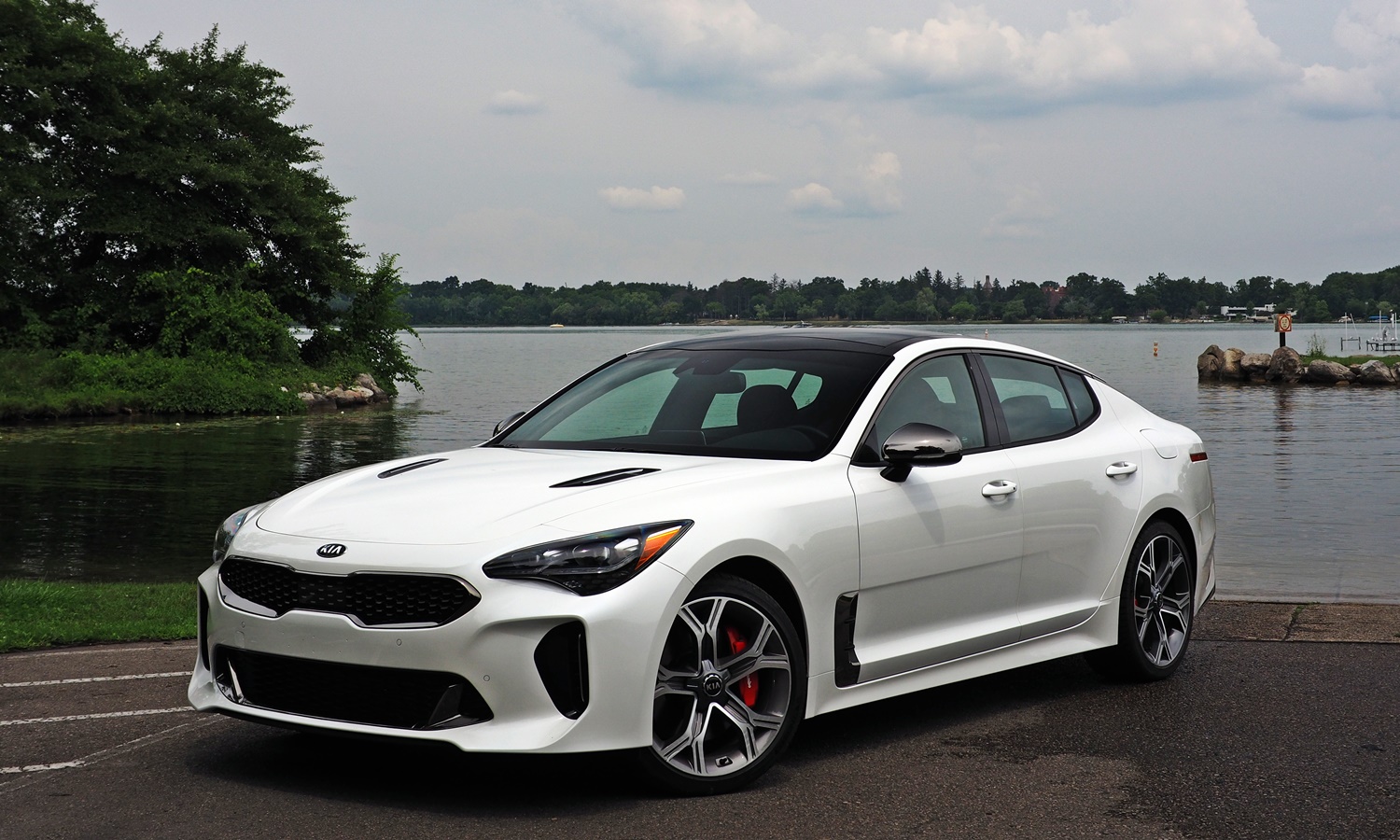
Curves and straight lines in all the right places. Most attractive four-door yet from Korea. more Stinger photos
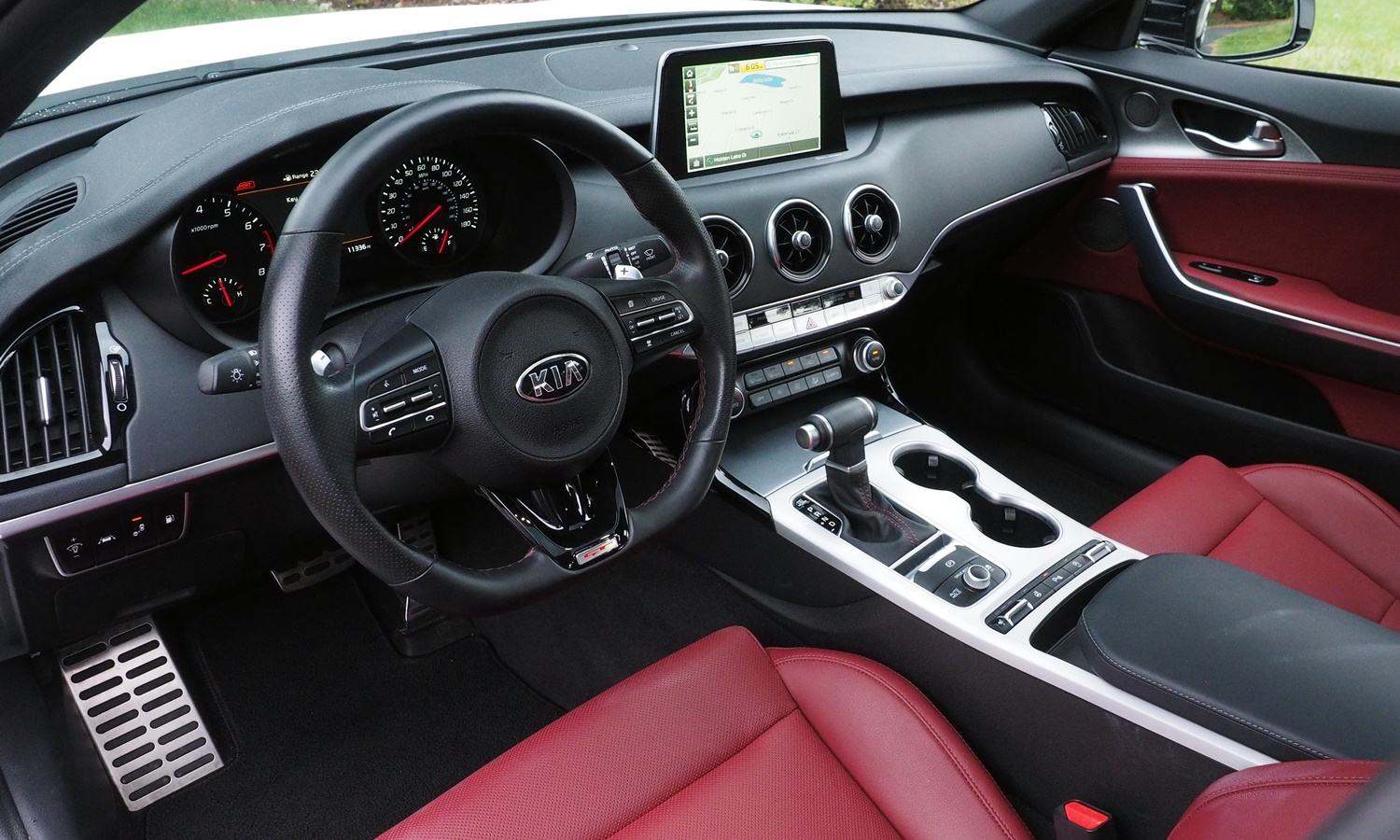
Faint retro vibe from the analog instruments and round vents.
| |
Compared to the A5 / S5 |
| Exterior styling |
 Better
Worse
Better
Worse
|
Liftbacks aren't always attractive. The exteriors of the first-gen Porsche Panamera, BMW 5 Series Gran Turismo, and Honda Crosstour set no hearts aflutter. Never mind those. With the new Stinger, Kia has realized the potential of the body style. It not only looks good, but sleeker, more muscular, and simply better than its German competitors. The Stinger's proportions are pretty much perfect. Viewed from the front, the Kia appears dramatically lower and wider than the upscale sedan norm--even though it isn't.
One detail could be better-executed: the reflector strips that extend well into the rear fenders appear tacked on. And some people might not care for the fender vents. But these are minor quibbles.
The Audi S5, with front-wheel-drive roots and consequently front wheels positioned closer to the passenger compartment, has pudgier, less elegant proportions. Also, while the first-gen S5 (available only as a coupe and convertible) was a timelessly beautiful car, the new one has a more massive nose and less cleanly styled body sides. It's still an attractive car, but the Stinger is stunning.
| Price or payments |
 Better
Worse
Better
Worse
|
As tested, the Kia Stinger listed for nearly $20,000 less than the Audi S5 Sportback. But the Audi had more features, including an $1,150 active steering system not offered on the Kia. Load both liftbacks up similarly, and the difference narrows to $14,000, $52,475 vs. $66,500. Adjusting for remaining feature differences shaves another $2,200. Even then the difference tops $10,000.
But wait, the Kia isn't the least expensive contender. Even in performance-oriented GS trim, the also new-for-2018 Buick Regal lists for about $8,000 less than the Kia Stinger GT. But the GS, though quicker than the four-cylinder Stinger, isn't as quick as the Stinger GT. More importantly, the Regal just isn't the same class of car. It doesn't provide nearly the same level of engagement as the Audi or the Kia, and it comes across as an Accord and Camry competitor that's been upgraded rather than a car designed from the ground up to compete with Audis and BMWs. To be fair, its price reflects this.
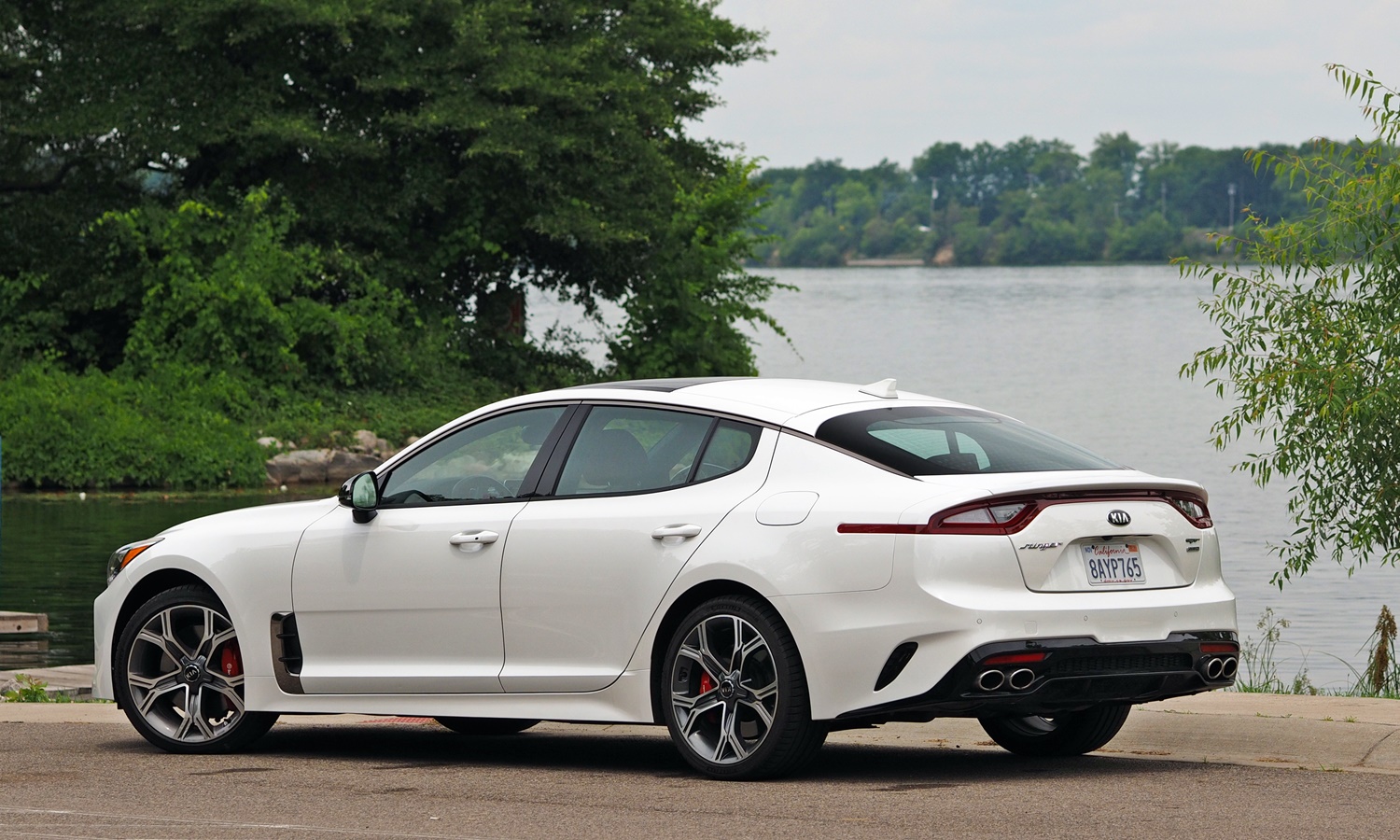
Similar window outline as the Optima sedan, but realizes its potential with a liftback body style.
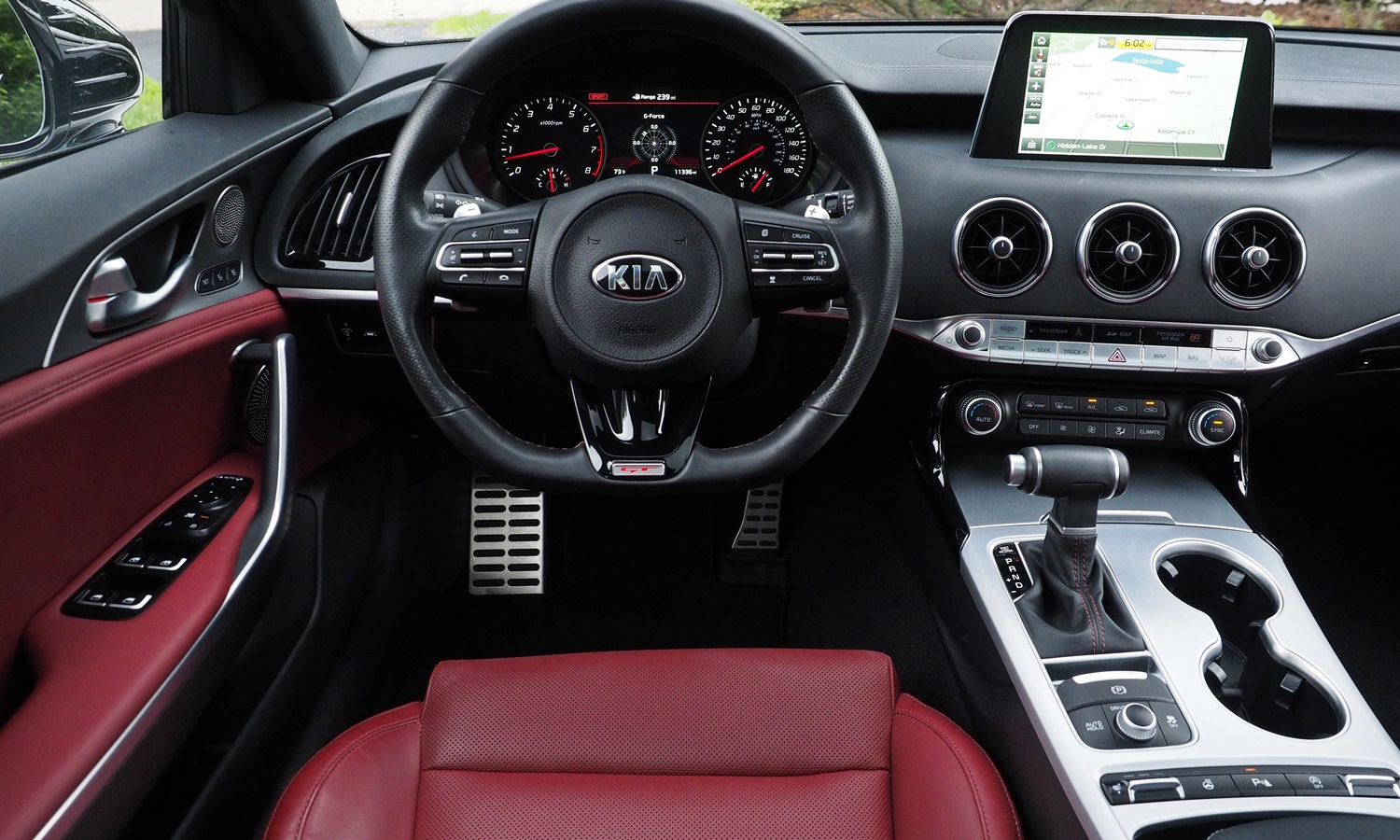
The touchscreen is a bit of a reach. Otherwise simple, well-designed controls.
| Powertrain performance |
 Better
Worse
Better
Worse
|
Compared to the S5 Sportback, the Kia Stinger GT is four inches longer, an inch wider, a half-inch taller, and (with AWD, standard on the Audi) about 100 pounds heavier. Against its slightly greater mass the Kia pits a slightly more powerful engine, a twin-turbocharged 3.3-liter V6 good for 365 horsepower (vs. the Audi's 354). The outcome: both cars are about equally quick according to the stopwatch. A hard run from a dead stop to 60 mph takes four seconds and change in either car.
Subjectively, the Kia feels somewhat stronger and more responsive than the Audi, especially right after you crack open the throttle and at low speeds. I suspect this is because the Audi engine is smaller, 3.0 vs. 3.3 liters, and relies on a large single turbo (instead of a pair of smaller turbos that spool up more rapidly) to compensate. The previous generation Audi S5 (and S4 sedan) employed a more responsive supercharged engine.
The Kia engine makes more noise, and generally has more character. With either car you can request additional synthetic engine noises via the audio system, but these noises seem artificial. I turned them off.
Both cars' engines are paired with manually shiftable eight-speed automatic transmissions. Doing its best to imitate the previous-generation S5's dual-clutch automated manual transmission, the Audi's automatic shifts more firmly and tightly than the Kia's, especially in "dynamic" mode. The Kia's transmission isn't quite as responsive, especially when manual shifts are requested via the paddles, but performs more than adequately.
Both the Kia and the Audi are also offered with 250-or-so horsepower turbocharged 2.0-liter four-cylinder engines, if you don't need (or don't want to pay for) the additional power of the V6s. With the four, the Stinger is just the Stinger, no "GT," and the Audi is the A5 rather than the S5. Want even more power? Then the Audi, also offered in 444-horsepower RS 5 form for 2019, becomes your only option in the class. (BMW doesn't yet offer any of its liftbacks in M form.)
| Front seat support & comfort |
 Better
Worse
Better
Worse
|
Spring for the top-of-the-line Stinger GT2, and the Kia's driver seat gains power adjustments for its side bolsters and cushion length. The tested car was a GT1, yet I did not miss these adjustments. The seat fit me very well without them.
I did miss the GT2's ventilated seats on hot days. And if your front seat passenger requires 4-way adjustable lumbar or either of you desires upgraded leather, then you'll also want the top trim.
The tested Audi S5 Sportback was fitted with optional ventilated seats. Unfortunately, upgrading to these seats deletes the otherwise standard power-adjustable side bolsters (and massage function), and in this car I did miss having them. Compared to the Kia's, the Audi's seats are much firmer and not nearly as form-fitting.
In my rating, I've assumed that the S5 Sportback's standard seats can be adjusted to provide better support than the optional ventilated seats. Otherwise I'd rate the Kia's front seats "much better."
Moving to the back seat, in either car headroom should be just enough for adults up to about six feet in height. This is a big improvement over the initial iteration of the S5 Sportback. That car never made it to North America because of a severe rear headroom deficiency. When it comes to rear knee and leg room, the Stinger offers about two-and-a-half more inches. Rear seat passengers are likely to prefer the Kia, especially if they can't quite fit behind a tall driver in the S5.
| Cargo capacity |
 Better
Worse
Better
Worse
|
While neither the Kia Stinger nor the Audi S5 Sportback has the cargo volume of a midsize crossover, or even a midsize wagon, either is much more versatile than a sedan.
My Olympus camera with a largish lens fit in the center console of both cars. In too many cars lately I've had to let it slide around the passenger's footwell.
| |
Compared to the A5 / S5 |
| Brand reputation & image |
 Better
Worse
Better
Worse
|
To get the obvious out of the way, many people will refuse to even consider the Stinger because it's a Kia. Sister company Hyundai gave up trying to sell upscale cars under its own badge, and made Genesis a separate brand. Back in the 1900s (some of us still remember that century well) Audi possessed considerably less cachet than BMW, much less Mercedes. But in the past decade Volkswagen's upscale arm has employed styling and technology to pull about even with them.
| Feature availability |
 Better
Worse
Better
Worse
|
With the Stinger, Kia has checked off pretty much all of my personal must-haves, save one: unlike in the related Genesis G70, you cannot get a manual transmission. Then again, you cannot get a manual transmission in any of the Stinger's competitors, either.
If Kia did want to hit the others where they aren't, the means is already in the corporate parts bin.
Looking at features more broadly, Audi offers quite a few that Kia does not. On the performance front, teh S5 Sportback can be optioned with an active steering system and an active rear differential. The Stinger offers a conventional limited-slip rear differential, but only on the rear-wheel-drive top-trim GT2. The S5 Sportback's driver assistance technologies are more thorough and sophisticated. For example, its adaptive cruise control takes map data into account, at low speeds the car is capable of semi-autonomy, and at higher speeds the car can often keep itself in the center of a lane. The Audi offers a 360-degree camera system. While many Kias also offer such a system, the Stinger does not. The S5 has Audi's highly reconfigurable LCD instrumentation. The Stinger has conventional instruments, albeit with a large driver information display between them. The Audi's infotainment system includes handwriting recognition. The Audi's rear seat air vents have automatic climate control, while the Stinger's have only a hot-cold manual temperature control. And so on.
In its favor, the upper trim levels of the Stinger have a power tilt-and-telescoping steering wheel, while the S5's is manual.
Overall, you can get about $4,000 in additional stuff on the Audi. But how much of it is of value to you?
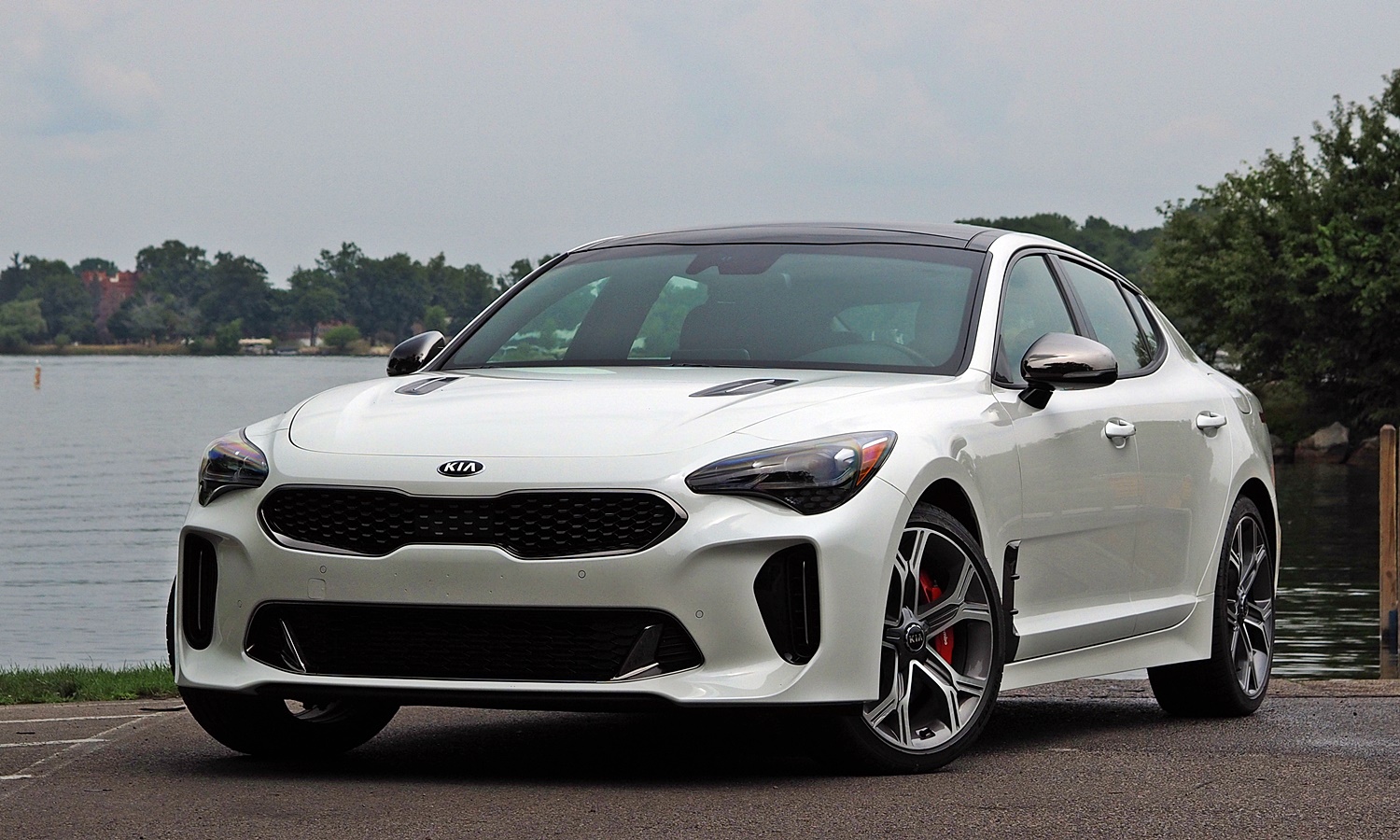
Skillfully styled front end appears wider and lower than it is.
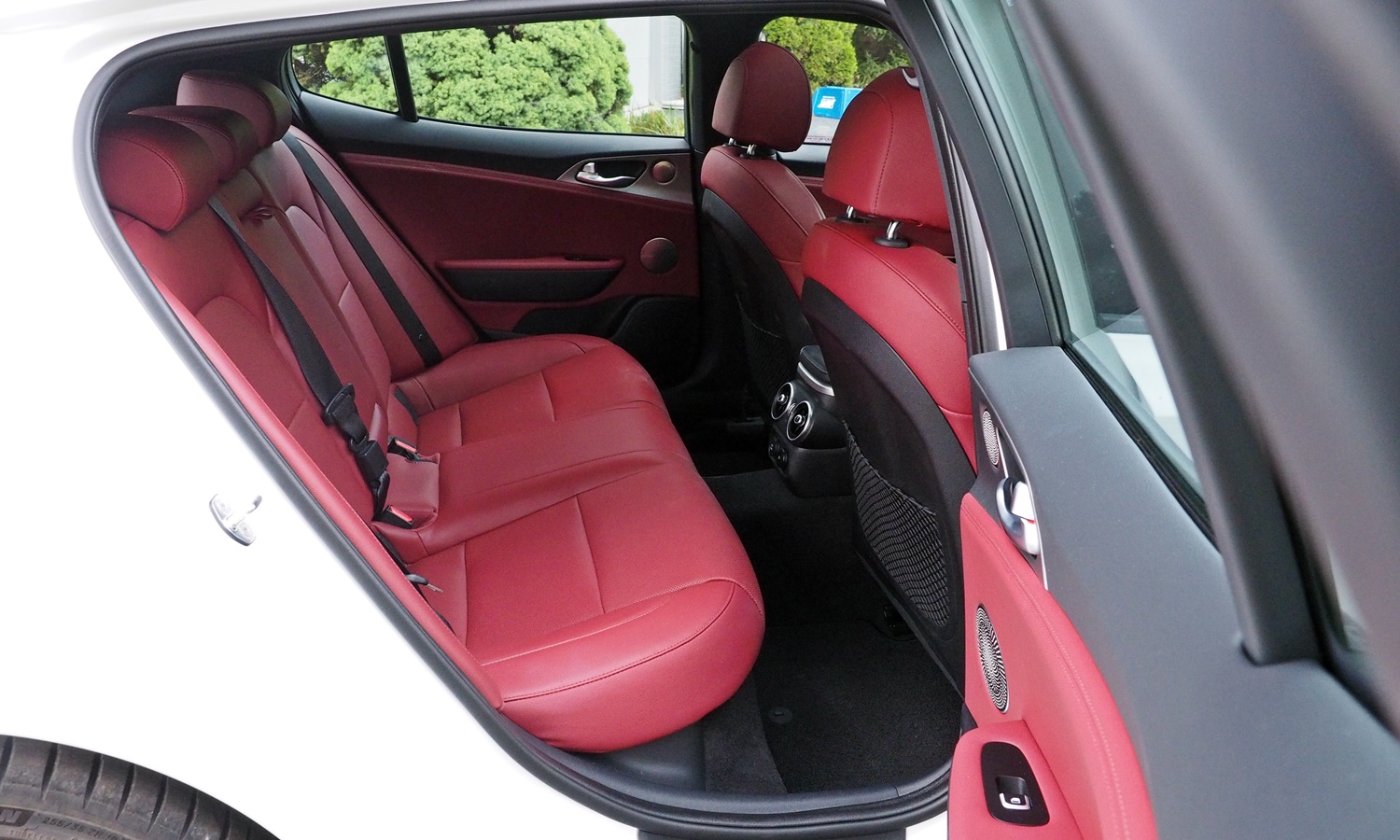
More rear knee and leg room than in the Audi. Merely adequate rear headroom in both.
| Materials & workmanship |
 Better
Worse
Better
Worse
|
The Kia Stinger doesn't look or feel cheap inside. Analog dial instruments and round air vents lend the interior an appealing faintly retro vibe. I don't know what inspired the distinctive shifter, but I like it as well.
Yet there's not denying that the Audi S5 Sportback's interior looks and feels considerably more upscale and sophisticated, doing much to justify the car's higher price. The German car's plastic seems less plasticky, and its every seam screams precision. On top of these standard amenities the tested car had the optional LCD instrumentation and optional carbon fiber trim, both decidedly fancier than the Kia's kit.
I could forgive the above differences as a matter of personal taste. Not everyone wants sophisticated and fancy. Less forgiveable: even over fairly smooth roads I often heard faint itching noises from the Kia's door seals. I heard the same in the related Genesis G80. I don't know what causes these noises. An insufficiently rigid body structure? The hinge or latch design? The composition of the seals? Proper lubrication might eliminate them.
| Fuel economy |
 Better
Worse
Better
Worse
|
Two-ton gas-powered cars that can reach 60 mph in under five seconds aren't going to match a Prius for fuel efficiency. But some (the Audi) are considerably more efficient than others (the Kia).
This doesn't happen by chance. The previous-generation Audi managed 18 mpg city and 28 mpg highway in the EPA's testing. Not awful for a car of its size and performance, but Audi knew it could do better. By substituting a turbocharger for its predecessor's supercharger, and the new S5 manages a commendable 21 mpg city and 30 mpg highway.
Kia, aiming at a moving target, fell short, with 19 mpg city and 25 mpg highway for both RWD and AWD versions of the GT. The four-cylinder Stinger rates 22/29 with RWD and 21/29 with AWD.
In my suburban driving I was able to coax the Stinger GT AWD as high as 26 mpg, but usually I observed averages around 20 mpg. On a 70-mph highway with the A/C running I easily beat the EPA rating with an observed 28.7 mpg. So maybe the Stinger just doesn't test well. Or maybe I had a tail wind.
| Driving position & visibility |
 Better
Worse
Better
Worse
|
Not to put too fine a point on it, rearward visibility from the Kia's driver seat is awful. In the rearview mirror the Stinger's rear window appears little more than a slot. In the Audi S5 Sportback, you have a more expansive view in all directions, and especially to the rear, thanks to larger windows and a less imposing instrument panel.
It's also more difficult to operate the Kia's infotainment system, as its touchscreen is much more of a reach than the Audi's console-mounted MMI knob. In fact, I initially searched for a knob in the Stinger, as the screen's distant location suggested remote operation.
| |
Compared to the A5 / S5 |
| Handling |
 Better
Worse
Better
Worse
|
Which car drives the best? Ultimately, it's a matter of taste.
When driven hard, the Audi S5 Sportback corners tightly, precisely, and with more balance than past largish Audis. Credit for the last is due the active rear differential, part of a must-have $2,500 Sport Package along with red brake calipers and adaptive dampers. Set the differential's mode to "comfort," and the S5 betrays its inherent nose-heaviness by plowing towards the outside of the curve more readily. Switch the diff back to "dynamic," and the liftback carves the exact line you intend, almost as if directly connected to your brain.
The $1,150 active steering when set to "dynamic" likely also deserves some credit. In hard cornering, the wheel feels unusually quick, direct, and precise for one in this class of car, helping the Audi feel more agile than the Kia. The edge of adhesion seems tangible. This steering also feels tight on-center at highway speeds. But in relatively casual driving, especially at sub-highway speeds, the S5's steering feels numb and artificial. I've noticed this sort of Jekyl-and-Hyde split personality in many German cars.
I have not driven the S5 with the standard steering system, so I don't know how much of a different the optional system makes.
Compared to the Audi, the Kia Stinger feels softer and less precise even when its steering and adaptive dampers are set to "sport." The suspension damping sometimes allows the body to bobble a bit. The Kia's steering varies less between modes than the Audi's and in general feels less quick, less firm, and less direct...yet also more fluid and less artificial. Though the Stinger also makes use of electronic controls for its steering and suspension, compared to the Audi it feels like an analog rather than a digital car. I've had a similar impression when comparing a Jaguar to a BMW or Audi. The German cars might be superior in a technical, objectively measurable sense, but the Jaguar--or the Kia--can be more enjoyable.
It doesn't hurt that the Stinger's chassis reacts more to throttle inputs. Mash the pedal all you want in the S5, you're not going to coax its rear end to go wide. At least I tried, yet could not. The Audi's electronics maintain a perfect, balanced line. Do the same in the Stinger, even with all-wheel-drive, and the car readily oversteers. Not enough to be dangerous, but certainly enough to have fun. It's the one to hoon.
The tested Stinger was fitted with all-wheel-drive. For an even livelier chassis, get the rear-wheel-drive GT2, which adds a limited-slip rear differential to the mix. But if your require all-wheel-drive for all-season capability, rest assured that a Stinger so configured still feels like a rear-wheel-drive car--while the Audi does not.
| Ride smoothness |
 Better
Worse
Better
Worse
|
And the flipside of handling? Both cars ride comfortably enough to use as daily drivers, even in the Detroit area. Both of the tested cars were fitted with adaptive dampers. These are included with the V6 on the Kia, but are part of a $2,500 Sport Package on the Audi. I actually preferred the Kia's ride with its dampers set to "sport." In "comfort" they permit too much bobble and float (by sport sedan standards). In any mode the Audi's ride can feel more nervous than the Kia's across small, nearly invisible road surface imperfections, and in general it rides a little more firmly.
| Quietness |
 Better
Worse
Better
Worse
|
Noise levels? The Stinger has laminated front side windows, and these might help keep more wind noise out of the Kia's cabin. But the Audi suppresses road noise better, especially on a concrete highway. This road noise differs more qualitatively than quantitatively. Relatively high-pitched in the Stinger, it's reduced to a low hum in the S5.
I'm overjoyed to see both Kia and Audi offering right-sized liftbacks. Both offer a combination of style and versatility you can't get in a sedan.
Objectively, the Audi S5 remains a superior car. It handles with more control and precision, has a more upscale interior, and goes farther on a gallon of gas. But the Kia Stinger has far more going for it than the expected much lower price. It looks better, has more comfortable seats, and can be more enjoyable to drive, especially in typical day-to-day driving. While the Audi is a thoroughly digital car, the Kia retains a more traditional, more analog character. In this sense, despite their similarities on the spec sheet, the Stinger and the S5 Sportback deliver categorically different driving experiences. Preferences will vary.
One box on my ideal family car list remains unchecked. Given the make's increasing emphasis on technology, it should come as no surprise that Audi no longer offers a manual transmission with any of its cars in North America, not even its TT sports car. But the Stinger's more analog character calls for a more analog transmission. Hyundai already offers one in the slightly smaller, closely related G70, if only with the four-cylinder engine. I'm hearing that the G70 also has somewhat firmer tuning than the Stinger (perhaps to the detriment of ride quality). Sadly, the G70 is a sedan. So I can get most of what I'd like in both the Stinger and the G70, but I can't get everything in either. Those with tastes like mine will have a tough choice to make.
That noted, if you're among the 99 percent of the population that prefers an automatic, no problem. Just sort out whether you prefer digital or analog, and buy accordingly.
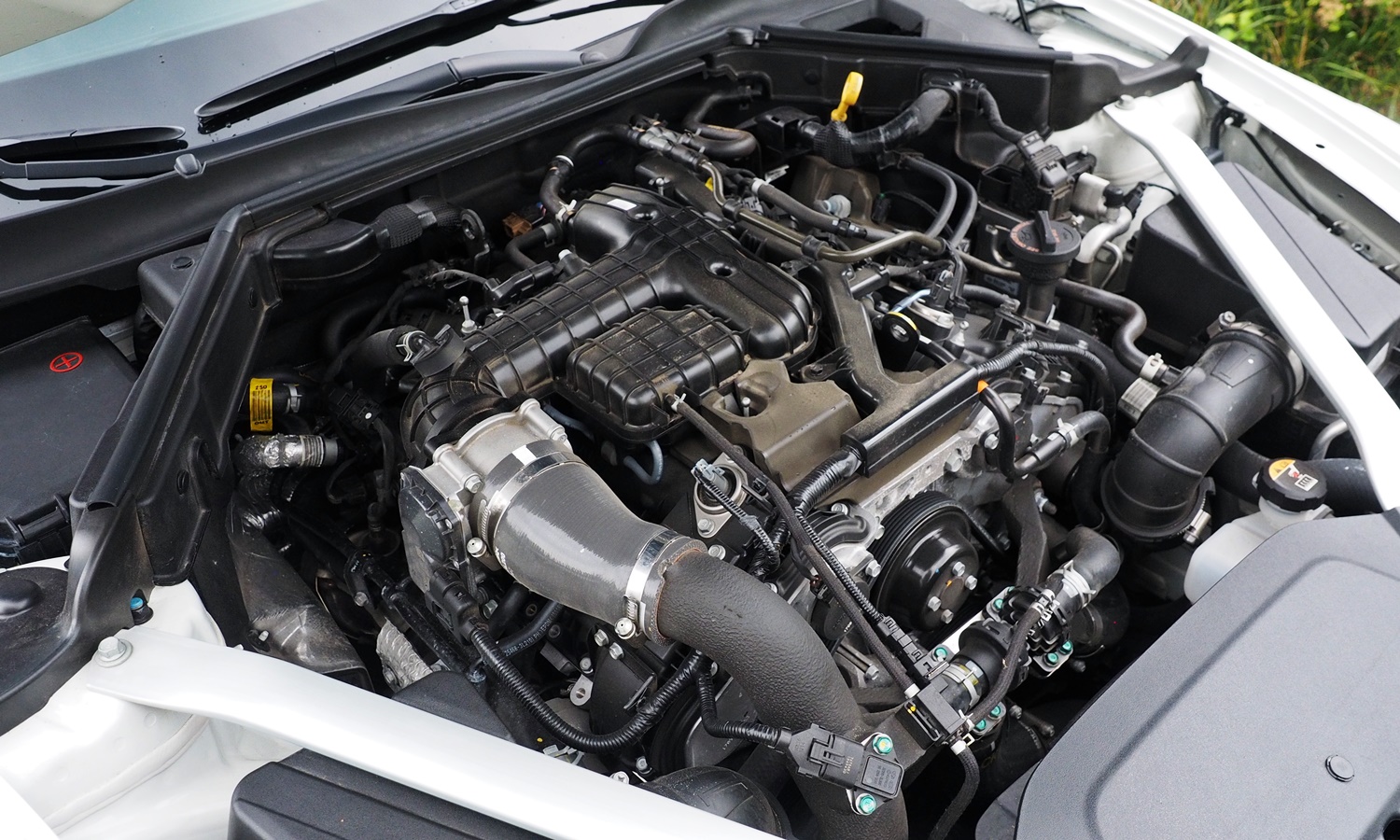
A pair of relatively small turbos contribute to a responsive and torquey 365-horsepower engine.
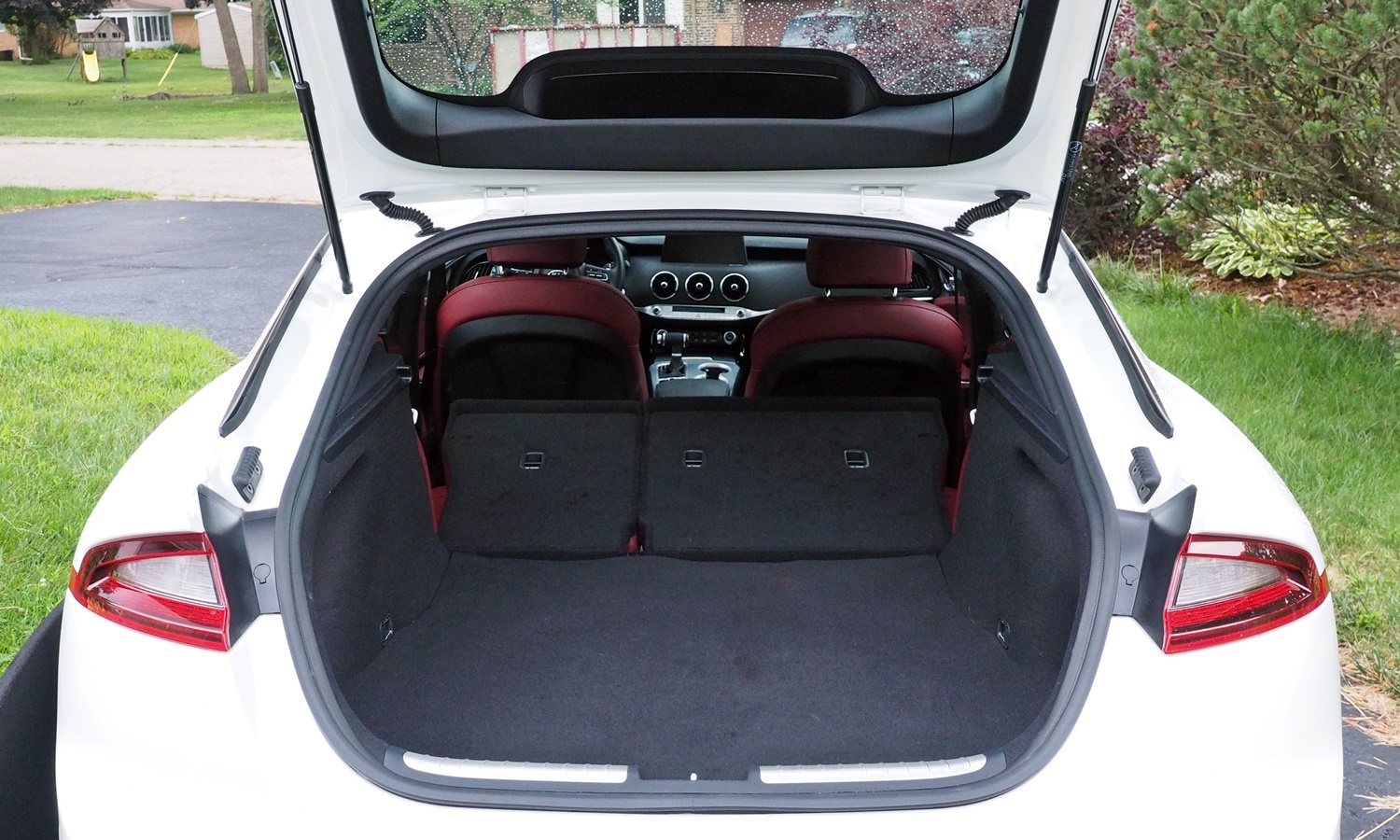
Why a liftback makes so much sense. Just toss your bicycle or that new TV in here.
See more 2018 Kia Stinger photos
Kia and Audi provided insured cars with a tank of gas.











